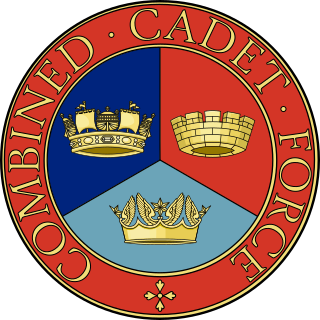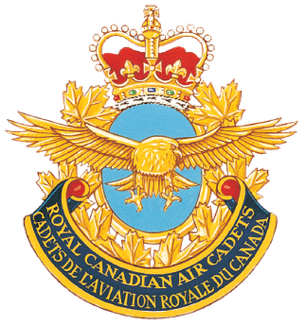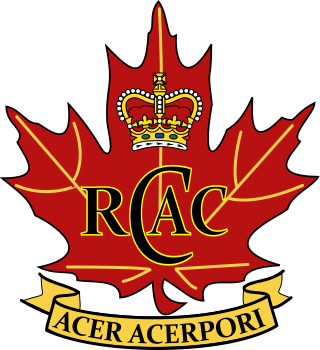The rank structures of the three elements of the Canadian Cadet Organizations are as follows, comparatively:
| CCO | Royal Canadian Air Cadets | Royal Canadian Army Cadets* | Royal Canadian Sea Cadets | Insignia Description |
| Senior Ranks | ||||
|---|---|---|---|---|
| CDT 8 | Warrant Officer First Class / Adjudant 1re classe (WO1 / adj 1) | Chief Warrant Officer / adjudant-chef (CWO / adjuc) | Chief Petty Officer First Class / premier maître de 1reclasse (CPO1 / pm1) | Simplified version of the 1957 Arms of Canada. (Worn only by the Squadron Warrant Officer/Chief (Air), Coxswain (Sea), or Regimental Sergeant Major (Army) of a corps/squadron, as selected through the merit review board process). *Multiple cadets may only hold this rank in the event of a transfer or transfers from other corps or squadrons.* |
| CDT 7 | Warrant Officer Second Class / Adjudant 2e classe (WO2 / adj 2) | Master Warrant Officer / adjudant-maître (MWO / adjum) | Chief Petty Officer Second Class / premier maître de 2eclasse (CPO2 / pm2) | Air: A St Edward's Crown within a wreath of maple leaves. Army, Sea: A St Edward's Crown within a laurel wreath. (Worn only by cadets selected through the merit review board process). |
| CDT 6 | Flight Sergeant / sergent de section (FSgt / sgts) | Warrant Officer / adjudant (WO / adj) | Petty Officer First Class / maître de 1re Classe (PO1 / m1) | Air: A three-bar chevron surmounted by a St Edward's Crown. Army, Sea: A St Edward's Crown. |
| CDT 5 | Sergeant / sergeant (Sgt / sgt) | Sergeant / sergent (Sgt / sgt) | Petty Officer Second Class / maître de 2e classe (PO2 / m2) | Air: A three-bar chevron Army: A three-bar chevron surmounted by a maple leaf. Sea: A three-bar chevron surmounted by two crossed anchors. |
| Junior Ranks | ||||
| CDT 4 | Flight Corporal / caporal de section (FCpl / cpls) | Master Corporal / caporal-chef (MCpl / cplc) | Master Cadet / matelot-chef (MC / matc) | Air: A two-bar chevron surmounted by a St Edward's Crown. Army: A two-bar chevron surmounted by a maple leaf. Sea: A two-bar chevron surmounted by an anchor. |
| CDT 3 | Corporal / caporal (Cpl / cpl) | Corporal / caporal (Cpl / cpl) | Leading Cadet / matelot de 1re classe (LC / mat1) | Air, Army, and Sea: A two-bar chevron. |
| CDT 2 | Leading Air Cadet / Cadet de l'air de 1er Classe (LAC / ca 1) | Lance Corporal / lance caporal (LCpl / lcpl) | Able Cadet / matelot de 2e classe (AC / mat2) | Air: One propeller. Army and Sea : A one-bar chevron. |
| CDT 1 | Air Cadet / cadet de l'air (AC / ca) | Cadet / cadet (Cdt / cdt) | Ordinary Cadet / matelot de 3e classe (OC / mat 3) | No insignia for all. |
*If an Army Cadet Corps has an affiliation with a unit of the Canadian Army that traditionally has different titles for the Ranks of "Private", "Corporal", and "Master Corporal", then they are then entitled to make use of those alternative titles for the ranks of "Lance Corporal", "Corporal, and "Master Corporal" in their units as well.
| Branch | Master Corporal | Corporal | Lance Corporal |
|---|---|---|---|
| Royal Canadian Armoured Corps | Master Corporal / caporal-chef (MCpl / cplc) | Corporal / caporal (Cpl / cpl) | Trooper / cavalier (Tpr / cav) |
| Royal Regiment of Canadian Artillery | Master Bombardier / bombardier-chef (MBdr / bdrc) | Bombardier / bombardier (Bdr / bdr) | Gunner / artilleur (Gnr / artr) |
| Corps of Royal Canadian Engineers | Master Corporal / caporal-chef (MCpl / cplc) | Corporal / caporal (Cpl / cpl) | Sapper / sapeur (Spr / spr) |
| Royal Canadian Corps of Signals | Master Corporal / caporal-chef (MCpl / cplc) | Corporal / caporal (Cpl / cpl) | Signalman / signaleur (Sgmn /[sig) |
| Corps of Royal Canadian Electrical and Mechanical Engineers | Master Corporal / caporal-chef (MCpl / cplc) | Corporal / caporal (Cpl / cpl) | Craftsman / artisan (Cfm / artn) |
| Royal Canadian Infantry Corps (RCIC) members of guards regiments | Master Corporal / caporal-chef (MCpl / cplc) | Corporal / caporal (Cpl / cpl) | Guardsman / garde (Gdm / gde) |
| RCIC members of rifle regiments | Master Corporal / caporal-chef (MCpl / cplc) | Corporal / caporal (Cpl / cpl) | Rifleman / carabinier (Rfm / car) |
| RCIC members of fusilier regiments | Master Corporal / caporal-chef (MCpl / cplc) | Corporal / caporal (Cpl / cpl) | Fusilier / fusilier (Fus / fus) |
| Highland (Scottish) Regiment | Master Corporal / caporal-chef (MCpl / cplc) | Corporal / caporal (Cpl / cpl) | Highlander / montagnarde (Hldr / mon) |
| RCIC members of voltigeur regiment | Master Corporal / caporal-chef (MCpl / cplc) | Corporal / caporal (Cpl / cpl) | Voltigeur / voltigeur (Vol / vol) |
In the guard regiments, Warrant Officers are known as "Colour Sergeants".







